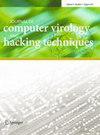利用私钥块对RSA进行部分密钥暴露攻击
IF 1.9
Q3 COMPUTER SCIENCE, INFORMATION SYSTEMS
Journal of Computer Virology and Hacking Techniques
Pub Date : 2023-11-08
DOI:10.1007/s11416-023-00507-9
引用次数: 0
摘要
RSA是公钥密码学中著名的密码系统,该密码系统的强度取决于分解大整数的难度。已经提出了几种利用秘密参数的部分信息进行攻击的方法,这些信息可以通过侧信道攻击获得。部分密钥暴露攻击利用由侧信道攻击获得的信息,并在攻击者知道部分信息的情况下识别RSA密码系统的潜力。在本文中,我们研究了RSA的强度,如果攻击者获得了秘密指数的一些块,并通过成功猜测RSA中任何素数的几个最高有效位(msb)。通过冷启动攻击可以提取秘密指数的一些块,并且可以正确猜出任意素数的一些msb。我们使用LLL算法来攻击RSA,并遵循Jochemsz和May方法来构造格。本文章由计算机程序翻译,如有差异,请以英文原文为准。
Partial key exposure attack on RSA using some private key blocks
RSA is a well-known cryptosystem in public-key cryptography and the strength of the cryptosystem depends on the hardness of factoring large integers. Several attacks have been proposed by using the partial information of the secret parameters, which can be obtained by side-channel attacks. Partial key exposure attacks exploit the information gained by a side-channel attack(s) and identify the potential of the RSA cryptosystem if an attacker knows that partial information. In this paper, we investigate the strength of RSA, if an attacker obtains some blocks of the secret exponent, and by guessing successfully a few most significant bits (MSBs) of any of the primes in RSA. Some blocks of the secret exponent can be extracted by cold boot attack and some MSBs of any of the primes can be guessed correctly. We apply LLL algorithm to attack the RSA and follow the Jochemsz and May approach to construct the lattice.
求助全文
通过发布文献求助,成功后即可免费获取论文全文。
去求助
来源期刊

Journal of Computer Virology and Hacking Techniques
COMPUTER SCIENCE, INFORMATION SYSTEMS-
CiteScore
4.00
自引率
13.30%
发文量
41
期刊介绍:
The field of computer virus prevention has rapidly taken an important position in our technological and information society. Viral attacks increase year after year, and antiviral efforts continually face new challenges. Beneficial applications of technologies based on scientific computer virology are still very limited. The theoretical aspects of the virus problem are only rarely considered, although many interesting and important open problems still exist. Little proactive research is focused on predicting the future of viral attacks.The Journal of Computer Virology and Hacking Techniques is an independent scientific and technical journal dedicated to viral and antiviral computer technologies. Both theoretical and experimental aspects will be considered; papers emphasizing the theoretical aspects are especially welcome. The topics covered by this journal include, but are certainly not limited to:- Mathematical aspects and theoretical fundamentals of computer virology - Algorithmics and computer virology - Computer immunology and biological models for computers - Reverse engineering (hardware and software) - Viral and antiviral technologies - Cryptology and steganography tools and techniques - Applications in computer virology - Virology and IDS - Hardware hacking, and free and open hardware - Operating system, network, and embedded systems security - Social engineeringIn addition, since computational problems are of practical interest, papers on the computational aspects of computer virology are welcome. It is expected that the areas covered by this journal will change as new technologies, methodologies, challenges and applications develop. Hacking involves understanding technology intimately and in depth in order to use it in an operational way. Hackers are complementary to academics in that they favour the result over the methods and over the theory, while academics favour the formalization and the methods -- explaining is not operating and operating is not explaining. The aim of the journal in this respect is to build a bridge between the two communities for the benefit of technology and science.The aim of the Journal of Computer Virology and Hacking Techniques is to promote constructive research in computer virology by publishing technical and scientific results related to this research area. Submitted papers will be judged primarily by their content, their originality and their technical and scientific quality. Contributions should comprise novel and previously unpublished material.However, prior publication in conference proceedings of an abstract, summary, or other abbreviated, preliminary form of the material should not preclude publication in this journal when notice of such prior or concurrent publication is given with the submission. In addition to full-length theoretical and technical articles, short communications or notes are acceptable. Survey papers will be accepted with a prior invitation only. Special issues devoted to a single topic are also planned.The policy of the journal is to maintain strict refereeing procedures, to perform a high quality peer-review of each submitted paper, and to send notification to the author(s) with as short a delay as possible. Accepted papers will normally be published within one year of submission at the latest. The journal will be published four times a year.
Note: As far as new viral techniques are concerned, the journal strongly encourages authors to consider algorithmic aspects rather than the actual source code of a particular virus. Nonetheless, papers containing viral source codes may be accepted provided that a scientific approach is maintained and that inclusion of the source code is necessary for the presentation of the research. No paper containing a viral source code will be considered or accepted unless the complete source code is communicated to the Editor-in-Chief. No publication will occur before antiviral companies receive this source code to update/upgrade their products.The final objective is, once again, proactive defence.This journal was previously known as Journal in Computer Virology. It is published by Springer France.
 求助内容:
求助内容: 应助结果提醒方式:
应助结果提醒方式:


